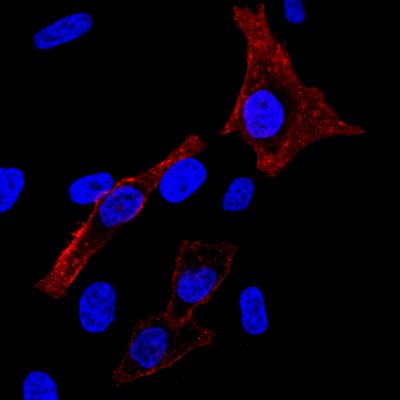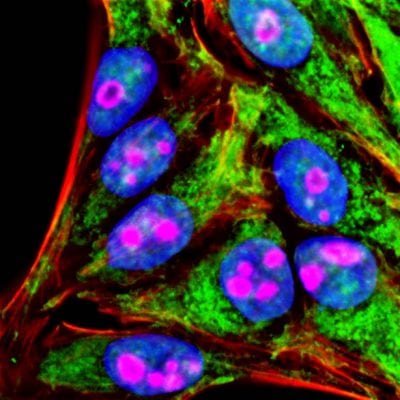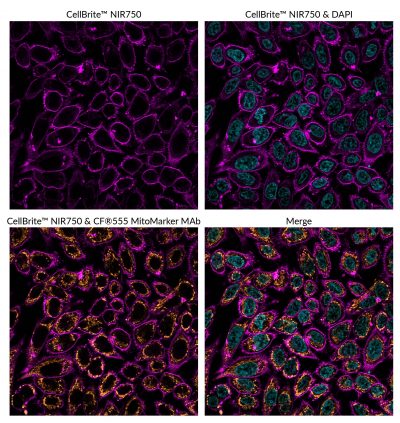DAPI, 10mg/mL in H2O
Referentie 40043
Formaat : 1ML
Merk : Biotium
DAPI
DAPI is a popular blue fluorescent DNA dye. The dye binds to the minor groove of dsDNA with approximately 20-fold fluorescence enhancement.
Product Description
DAPI (4′,6-Diamidino-2-Phenylindole, dihydrochloride) is a popular blue DNA dye that is used as a nuclear counterstain in fluorescence microscopy, chromosome staining, and flow cytometry. The dye binds to the minor groove of dsDNA with approximately 20-fold fluorescence enhancement, with higher affinity for A-T rich regions.
- Classic blue nuclear counterstain for fixed cells
- Available as a powder or solution
- λEx/λEm (with DNA) = 358/461 nm
- Store at 4°C and protect from light, especially in solution
DAPI as a dilactate powder is more water soluble than the dihydrochloride salt, and therefore a better choice for preparing stock solutions in water. If mounting media will be used, we also offer anti-fade mounting media containing DAPI, in both hardset and wetset formulations. Having trouble with your experiments? See our section on troubleshooting tips for fluorescent staining.
| Product | Catalog Number | MW | Unit Size | Format |
|---|---|---|---|---|
| DAPI Powder (dilactate) | 40009 | 457.49 | 10 mg | Yellow solid |
| DAPI Powder (dihydrochloride) | 40011 | 350.25 | 10 mg | Yellow solid |
| DAPI Solution (dilactate) | 40043 | 457.49 | 1 mL (10 mg/mL in water) | Yellow solution |
Find the Right Nuclear Stain for Your Application
DAPI can be used to stain mammalian cells as well as gram-positive and gram-negative bacteria. In yeast, the staining is weak and not nuclear. DAPI is less membrane permeant than Hoechst, and is typically used to stain fixed cells. On the other hand, Hoechst dyes are membrane-permeant and more often used for live or fixed cell staining and cell cycle analysis. While Hoechst and DAPI show less cytotoxicity than intercalating DNA dyes, they bind DNA in living cells and are potentially hazardous. DAPI and Hoechst undergo photoconversion by UV excitation to form green fluorescent dyes, which can lead to artifacts in multi-color imaging. See our Tech Tip Avoiding Artifacts from UV Photoconversion of DAPI and Hoechst for more information.
Biotium also offers unique NucSpot® Nuclear Stains for bright and specific nuclear staining in dead or fixed cells. The stains are available in a wide range of colors from green to near-IR. See our Cellular Stains Selection Guide and Cellular Stains Table for more information on other nuclear stains we offer.
References
- Gastroenterology, 158, 985, (2020), DOI: 10/ggt7b5
- Front. Cell Dev. Biol., 7, 321, (2020), DOI: 10/ggt677
- Int. J. Biol. Sci., 16, 1586, (2020), DOI: 10/ggt7nv
- Poultry Science, 99, 1209, (2020), DOI: 10/ggt7cj
- Acta Biomaterialia, 107, 138, (2020), DOI: 10/ggt8d9
- Int. J. Med. Sci., 17, 480, (2020), DOI: 10/ggt8fb
- Nat Commun, 11, 1416, (2020), DOI: 10/ggt74m
- Polymers, 12, 329, (2020), DOI: 10/ggt8fg
- Biomed Pharmacother., 119, 109420, (2019), DOI: 10/ggt7cw
- Redox Biology, 26, 101220, (2019), DOI: 10/ggt7dg
- Front. Cell Dev. Biol., 7, 224, (2019), DOI: 10/ggszm9
- Sci Rep, 9, 2102, (2019), DOI: 10/ggt7mq
- Nanoscale, 11, 18255, (2019), DOI: 10/ggt8ff
- Am J Physiol Gastrointest Liver Physiol, 317, G531, (2019), DOI: 10/ggt8fh
- Ecotoxicol Environ Saf., 183, 109583, (2019), DOI: 10/ggt7c9
- Biotechnic Histochem, 70, 220, (1995), DOI: 10.3109/10520299509108199






